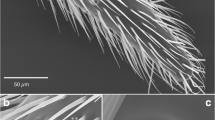Summary
The twoPseudomyrmex species studied have the following communication systems:
-
a)
P. triplarinus informs its nestmates about the presence of food, but not about its location.P. termitarius does neither.
-
b)
Both species recognize their territory and/or area around the nest entrance through odours on the substrate.P. triplarinus marks its territory with a pheromone from the thorax, probably from the metapleural gland. This territorial mark lasts less than 1 h, and probably advertises at least part of the home range of the colony. The territorial odour used byP. termitarius, probably works as a nest entrance orientation mark, and lasts over 5 h, but less than 24 h. The origin of the odour is not clear.
-
c)
P. triplarinus uses a cephalic pheromone as the main signal for nestmate recognition.P. termitarius uses non-identified odours, present on all body parts of the insect, as a nestmate recognition signal.
-
d)
Both species produce alarm pheromones from the head and the gaster.
The communication systems are interpreted in relation to the ecological adaptations of each species.
Zusammenfassung
Die zwei untersuchtenPseudomyrmex-Arten haben die folgenden Kommunikationssysteme:
-
a)
P. triplarinus informiert ihre Nestgenossinnen über das Vorhandensein von Futter, aber nicht über dessen Lage.P. termitarius hat keinerlei Kommunikation bei der Futtersuche.
-
b)
Beide Arten erkennen ihr Territorium anhand von Duftstoffen.P. triplarinus markiert ihr Territorium mit einem Pheromon aus dem Thorax, wahrscheinlich von der Metathorakaldrüse. Die territoriale Markierung hat eine Lebensdauer von einer halben bis einer Stunde. Sie dient wahrscheinlich der Verteidigung des Territoriums. Die Markierung vonP. termitarius hält über 5 Stunden an und wirkt wahrscheinlich als Nesteingangs-Orientierungsmarke. Die Herkunft des Duftstoffes ist nicht klar.
-
c)
P. triplarinus benützt ein Pheromon aus dem Kopf als Signal für das Erkennen ihrer Schwestern.P. termitarius verwendet nicht-identifizierte Duftstoffe, die überall im Körper vorhanden sind, als Identifikationssignal.
-
d)
Beide Arten haben Alarmpheromone im Kopf und im Abdomen.
Die Kommunikationssysteme werden im Zusammenhang mit der oekologischen Adaption der Arten analysiert.
Similar content being viewed by others
References
Bradshaw J.W.S., Baker R., Howse P.E., 1975. — Multicomponent alarm pheromones of the weaver ant.Nature, 258, 230–231.
Cammaerts M.C., Morgan E.D., Tyler R., 1977. — Territorial marking in the antmyrmica rubra.Biol. Behav., 2, 263–272.
Dumpert K., 1978. —Das Sozialleben der Ameisen. Verlag Paul Parey, Berlin, 253 pp.
Hölldobler B., 1978. — Ethological aspects of chemical communication in ants.Adv. Study Behav.,8, 57–120.
Hölldobler B., Wilson E.O., 1977. — Colony specific territorial pheromone in the African weaver antOecophylla longinoda.Proc. Natl. Acad. Sci. U.S.A., 74, 2072–2075.
Howse P.E., Bradshaw J.W.S., 1980. — Chemical systematics of social insects with particular reference to ants and termites.Systematics Association (G.B.) special Volume16, 71–90.
Jaffe K. 1983. — Chemical communication among worker of leaf-cutting ants.Social Insects in the Tropics, Jaisson Ed., Univ. Paris Nord, Vol. 2, 165–180.
Jaffe K., 1984. — Negentropy and the evolution of chemical recruitment in ants.J. theor. Biol.,106, 587–604.
Jaffe K., Howse P.E., 1979. — The mass recruitment system of the leaf-cutting antAtta cephalotes Anim.Behav., 27, 931–939.
Jaffe K., Marcuse M., 1983. — Individual recognition and territorial behaviour in the antOdontomachus bauri.Insectes Sociaux, 30, 466–481.
Jaffe K., Puche H., 1984. — Territorial marking with the metapleural gland secretion in the antSolenopsis geminata.J. Insect Physiol., 30, 265–270.
Jaffe K., Sanchez C., 1984. — Nestmate recognition and territorial behaviour in the antCamponotus rufipes.Insectes Sociaux, 31, 302–315.
Jaffe K., Villegas G., 1985. — On the communication systems of the fungus growing antTrachymyrmex urichi.Insectes Sociaux, 32, 257–274.
Jaffe K., Navarro J.G., 1985. — Communication quimica entre obreras de la hormiga cortadora de gramaAcromyrmex landolti. Rev. brasilera Entomol., (in press).
Jaffe K., Bazire-Benazet M., Howse P.E., 1979. — An integumentary pheromone secreting gland inAtta spp; territorial marking with a colony specific pheromone inAtta cephalotes.J. Insect Physiol., 25, 833–839.
Janzen D., 1967. — Interaction of the Bull's-horn Acacia (Acacia cornigera L.) with an ant inhabitant (Pseudomyrmex ferruginea) in eastern Mexico.Univ. Kansas Sci. Bull., 67, 315–558.
Kempf W., 1972. — Catalogo abreviado das formigas da regiao neotropical.Studia Entomol., 15, 1–344.
Mill A.E., 1981. — Observations on the ecology ofPseudomyrmex termitarius in Brazilian savanas.Rev. Bras. Entomol., 25, 271–274.
Mintzer A., 1982. — Genetic models of colony odor and nestmate recognition.The Biology of Social Insects, Proc. IUSSI Congr. Boulder, Colorado, p. 6 (Sup.).
Pittier H., 1926. — Manual de las Plantas usuales de Venezuela.Fundacion Eugenio Mendoza, Caracas, 1971; 620 pp.
Author information
Authors and Affiliations
Rights and permissions
About this article
Cite this article
Jaffé, K., Lopez, M.E. & Aragort, W. On the communication systems of the antsPseudomyrmex termitarius andP. triplarinus . Ins. Soc 33, 105–117 (1986). https://doi.org/10.1007/BF02224591
Received:
Accepted:
Issue Date:
DOI: https://doi.org/10.1007/BF02224591




